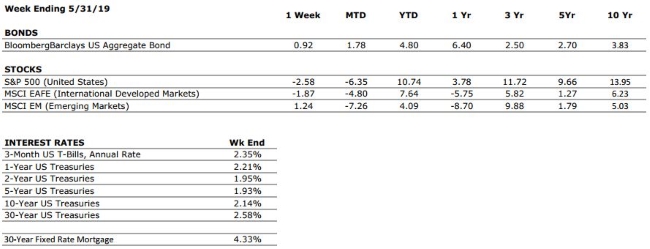by
Connor
Darrell CFA, Assistant Vice President – Head
of Investments
A
weaker than expected jobs report fed rising speculation that the Federal
Reserve will opt to lower interest rates in the coming months, leading to a
rally in equities that saw the S&P 500 rise by more than 4% last week.
Global manufacturing data also released during the week seemed to lend further
credence to this sentiment as trade tensions pushed global manufacturing
activity into contraction and down to its lowest reading since October of 2012.
It is becoming increasingly clear that the uncertainty related to global trade
is having an impact on business investment, and with the tensions likely to
persist in the near-term, investors should be prepared for additional
volatility in markets.
Don’t
Rely on the “Powell Put”
With
the sudden escalation of global geopolitical uncertainty threatening to slow
business investment and reduce economic growth, Federal Reserve policymakers
have found themselves in a very difficult (und unique) environment in which to
operate. Perhaps in response to the very high levels of uncertainty coming from
other areas of the financial world, it seems that Fed officials have made a
concerted effort to be extra communicative in recent months. For example,
during the last week of May (which included a market holiday), there were 13
separate speeches given by Fed officials; a staggering number when you consider
that the Federal reserve already meets two times per quarter and releases
detailed notes for public consumption after each meeting. It seems that the
Federal Reserve has felt the need to address the shorter-term shocks to markets
that have resulted from setbacks in trade negotiations and other geopolitical
concerns by constantly reminding investors that it is watching things very closely.
The timing of many of these statements has coincided
with rising levels of volatility in markets, leading some to refer to current
Fed policy as the “Powell Put.” With the Fed under the microscope, it is easy
overestimate its power and lose focus on all of the other factors that drive
markets over the long-term. In the
context of a $20 trillion economy, one or two 25-basis-point adjustments to
short-term interest rates are unlikely to have a profound impact on the
trajectory of economic growth, and investors would be well-served by broadening
their focus. In fact, we would argue that the most important thing for
investors to focus on is portfolio construction, and that this is the case no
matter what stage of the economic cycle we find ourselves in. The interaction
of monetary policy, the economy, and the stock market has become a defining
characteristic of the current economic cycle, but it shouldn’t be the key input
to determining the composition of one’s portfolio.




 Lehigh Valley Business had invited our
Founder & Chairman, Thomas Riddle, to participate in a panel discussion
about Succession Planning at their Business Growth Symposium the morning of
June 13 at DeSales University. Tom will share his planning approach and
experience with the panel and audience.
Lehigh Valley Business had invited our
Founder & Chairman, Thomas Riddle, to participate in a panel discussion
about Succession Planning at their Business Growth Symposium the morning of
June 13 at DeSales University. Tom will share his planning approach and
experience with the panel and audience.